Sodium chromate tetrahydrate
- CAS NO.:10034-82-9
- Empirical Formula: CrH5NaO5
- Molecular Weight: 160.02
- MDL number: MFCD00149167
- EINECS: 600-068-7
- SAFETY DATA SHEET (SDS)
- Update Date: 2023-10-17 17:11:57
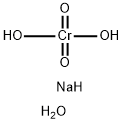
What is Sodium chromate tetrahydrate?
Chemical properties
yellow deliquescent crystals
Chemical properties
Sodium cyanide is found as white granules, flakes or lumps. Sodium cyanide is shipped as pellets or briquettes. Odorless when dry. It absorbs water from air (is hygroscopic or deliquescent). Hydrogen cyanide gas released by sodium cyanide has a distinctive mild, bitter almond odor, but a large proportion of people cannot detect it; the odor does not provide adequate warning of hazardous concentrations.
Chemical properties
Sodium chromate, including the hexahydrate, is yellow crystalline solids that can also be used in solution. Disodium dichromate (10588-01-9):
The Uses of Sodium chromate tetrahydrate
Corrosion inhibitor, pigment manufactureSodium chromate tetrahydrate is used as a corrosion inhibitor, wood preservative and an auxiliary in textile industry. It serves as an oxidant, which is used to prepare carboxylic acids and ketones from primary and secondary alcohols respectively. Further, it is used as a starting material to prepare other chromium compounds and as a catalyst in organic synthesis especially pharmaceuticals and agro chemicals.
The Uses of Sodium chromate tetrahydrate
Sodium chromate tetrahydrate can be used as an oxidant in organic synthesis and also as a carrier electrolyte in the capillary electrophoresis.
General Description
Odorless bright yellow deliquescent crystals. Aqueous solutions are alkaline.
Air & Water Reactions
Deliquescent. Water soluble.
Reactivity Profile
Sodium chromate tetrahydrate is a strong oxidizing agent. Incompatible with strong acids . Contact with combustible materials may lead to a fire. Toxic chromium oxide fumes may form in fire [USCG, 1999].
Fire Hazard
Literature sources indicate that Sodium chromate tetrahydrate is nonflammable.
Potential Exposure
Used to make dyes, inks, pigments, and other chromates; in leather tanning, a corrosion inhibitor in circulating water systems; metal treatment; a drilling mud additive; chemical intermediate for chromium catalysts; colorimetry, oxidizing agent; bleaching agent; an algicide, fungicide, insecticide; in wood preservation.
Shipping
UN3087 Oxidizing solid, toxic, n.o.s., Hazard Class: 5.1; Labels: 5.1-Oxidizer, 6.1-Poisonous materials, Technical Name Required. UN3085 Oxidizing solid, corrosive, n.o.s., Hazard Class: 5.1; Labels: 5.1-Oxidizer, 8-Corrosive material, Technical Name Required.
Purification Methods
Crystallise the chromate from hot water (0.8mL/g). It is deliquescent.
Incompatibilities
Sodium cyanide decomposes on contact with acids, acid salts, water, moisture, alcohols, and carbon dioxide, releasing highly toxic and flammable hydrogen cyanide gas. Aqueous solution is a strong base; it reacts violently with acid and is corrosive. Incompatible with oxidizers (chlorates, nitrates, peroxides, permanganates, perchlorates, chlorine, bromine, fluorine, etc.); contact may cause fires or explosions. Keep away from alkaline materials, strong bases, strong acids, oxoacids, epoxides. Absorbs moisture from the air forming a corrosive syrup. Corrosive to active metals, such as aluminum, copper, and zinc. Under acid conditions, sarin hydrolyzes to form hydrofluoric acid.
Waste Disposal
Consult with environmental regulatory agencies for guidance on acceptable disposal practices. Generators of waste containing this contaminant (≥100 kg/mo) must conform to EPA regulations governing storage, transportation, treatment, and waste disposal. In accordance with 40CFR165, follow recommendations for the disposal of pesticides and pesticide containers. Must be disposed properly by following package label directions or by contacting your local or federal environmental control agency, or by contacting your regional EPA office. Add strong alkaline hypochlorite and react for 24 hours. Then flush to sewer with large volumes of water.
Properties of Sodium chromate tetrahydrate
| Melting point: | 792℃ |
| Density | 2.73 |
| solubility | slightly soluble in ethanol |
| form | Crystals |
| color | Yellow |
| Odor | Odorless |
| PH | pH (10g/l, 25℃) : 8.0~10.0 |
| Water Solubility | Soluble in water. |
| Sensitive | Hygroscopic |
| Merck | 14,8601 |
| Exposure limits | ACGIH: TWA 0.0002 mg/m3; STEL 0.0005 mg/m3 (Skin) OSHA: Ceiling 0.1 mg/m3 NIOSH: IDLH 15 mg/m3; TWA 0.0002 mg/m3 |
| Stability: | Stable. Incompatible with strong reducing agents, combustible materials, strong acids. Deliquescent. |
| CAS DataBase Reference | 10034-82-9(CAS DataBase Reference) |
| EPA Substance Registry System | Sodium chromate(VI), tetrahydrate (10034-82-9) |
Safety information for Sodium chromate tetrahydrate
| Signal word | Danger |
| Pictogram(s) |
 Corrosion Corrosives GHS05  Skull and Crossbones Acute Toxicity GHS06  Health Hazard GHS08  Environment GHS09 |
| GHS Hazard Statements |
H301:Acute toxicity,oral H312:Acute toxicity,dermal H314:Skin corrosion/irritation H317:Sensitisation, Skin H330:Acute toxicity,inhalation H334:Sensitisation, respiratory H340:Germ cell mutagenicity H350:Carcinogenicity H372:Specific target organ toxicity, repeated exposure H410:Hazardous to the aquatic environment, long-term hazard |
| Precautionary Statement Codes |
P260:Do not breathe dust/fume/gas/mist/vapours/spray. P273:Avoid release to the environment. P280:Wear protective gloves/protective clothing/eye protection/face protection. P303+P361+P353:IF ON SKIN (or hair): Remove/Take off Immediately all contaminated clothing. Rinse SKIN with water/shower. P305+P351+P338:IF IN EYES: Rinse cautiously with water for several minutes. Remove contact lenses, if present and easy to do. Continuerinsing. |
Computed Descriptors for Sodium chromate tetrahydrate
Abamectin manufacturer
ARRAKIS INDUSTRIES LLP
Buradon Inc.
New Products
4-AMINO-TETRAHYDRO-PYRAN-4-CARBOXYLIC ACID HCL 4-(Dimethylamino)tetrahydro-2H-pyran-4-carbonitrile 4-Aminotetrahydropyran-4-carbonitrile Hydrochloride (R)-3-Aminobutanenitrile Hydrochloride 3-((Dimethylamino)methyl)-5-methylhexan-2-one oxalate 1,4-Dioxa-8-azaspiro[4.5]decane 5-Bromo-2-nitropyridine Nimesulide BP Aceclofenac IP/BP/EP Diclofenac Sodium IP/BP/EP/USP Mefenamic Acid IP/BP/EP/USP Ornidazole IP Diclofenac Potassium THOMAIND PAPER PH 2.0 TO 4.5 1 BOX BUFFER CAPSULE PH 9.2 - 10 CAP SODIUM CHLORIDE 0.1N CVS ALLOXAN MONOHYDRATE 98% PLATINUM 0.5% ON 3 MM ALUMINA PELLETS (TYPE 73) LITHIUM AAS SOLUTION 2-Bromo-1-(bromomethyl)-3-chloro-5-nitrobenzene 2-Bromo-3-nitroaniline N-(3-Hydroxypropyl)-N-methylacetamide 3-Bromo-6-chloropyridazine 4-ethyl-3-nitrobenzoic acidRelated products of tetrahydrofuran

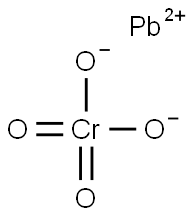
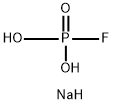
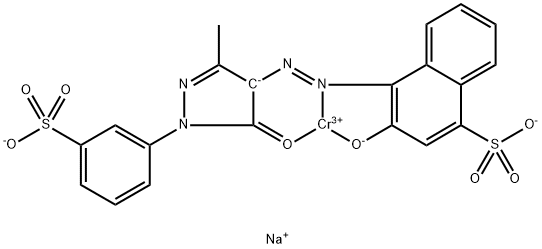
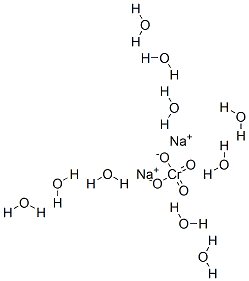

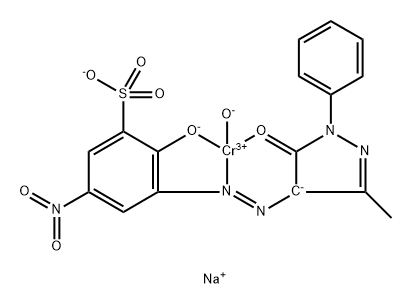
![sodium bis[3-[(4,5-dihydro-3-methyl-5-oxo-1-phenyl-1H-pyrazol-4-yl)azo]-4-hydroxybenzene-1-sulphonamidato(2-)]chromate(1-)](https://img.chemicalbook.in/CAS/20211123/GIF/72275-69-5.gif)
You may like
-
 Sodium chromate tetrahydrate CAS 10034-82-9View Details
Sodium chromate tetrahydrate CAS 10034-82-9View Details
10034-82-9 -
 Sodium chromate, tetrahydrate, GR 99%+ CAS 10034-82-9View Details
Sodium chromate, tetrahydrate, GR 99%+ CAS 10034-82-9View Details
10034-82-9 -
 Sodium chromate tetrahydrate 99% CAS 10034-82-9View Details
Sodium chromate tetrahydrate 99% CAS 10034-82-9View Details
10034-82-9 -
 Sodium chromate, tetrahydrate CAS 10034-82-9View Details
Sodium chromate, tetrahydrate CAS 10034-82-9View Details
10034-82-9 -
 SODIUM CHROMATE TETRAHYDRATE AR CAS 10034-82-9View Details
SODIUM CHROMATE TETRAHYDRATE AR CAS 10034-82-9View Details
10034-82-9 -
 SODIUM CHROMATE TETRAHYDRATE Extra Pure CAS 10034-82-9View Details
SODIUM CHROMATE TETRAHYDRATE Extra Pure CAS 10034-82-9View Details
10034-82-9 -
 Sodium chromate tetrahydrate 99% AR CAS 10034-82-9View Details
Sodium chromate tetrahydrate 99% AR CAS 10034-82-9View Details
10034-82-9 -
 Sodium chromate tetrahydrate CAS 10034-82-9View Details
Sodium chromate tetrahydrate CAS 10034-82-9View Details
10034-82-9